12 Eco-Friendly Alternatives To Glitter For A Green Sparkle
To support the running costs of Moral Fibres, this post may contain affiliate links. This means Moral Fibres may earn a small commission, at no extra cost to readers, on items purchased through these links.
If you’re looking for all the fun of glitter, without the microplastic-based litter, then I’ve got lots of eco-friendly alternatives to glitter for you to try. Whether it’s for craft projects or cosmetics, there are heaps of sustainable alternatives out there.
Glitter has long been a staple in arts and crafts and cosmetics. Whether it’s adding a bit of shimmer and sparkle to our faces or our artwork, for years we’ve all been reaching for the glitter.
However, traditional glitter is typically composed of microplastics. These are teeny-tiny pieces of plastic that when washed off our hands or bodies can be harmful to ocean and aquatic life.
As well as being considered a microplastic, most traditional glitter is made of a blend of aluminium and a plastic called PET. PET can break down to release chemicals that disrupt hormones in the bodies of both animals and humans. These hormones can in turn cause serious illnesses.
It’s hard to believe that something so fun and seemingly innocuous as glitter could harbour such environmental destruction. Yet it does all whilst leaving behind a sparkly trail. In response to these concerns, in October 2023 traditional glitter was banned across the European Union.
What About Biodegradable Glitter?
Biodegradable glitter might sound like a promising alternative to traditional glitter, however, it’s not all it cracked up to be.
Studies have found that biodegradable glitter causes the same damage to rivers as standard glitter, so it’s not something I recommend.
12 Sustainable Alternatives To Glitter To Try

If you can’t live in a world without glitter, but don’t want to damage the environment then fear not. I have twelve eco-friendly glitter alternatives for all your sparkly cosmetic and crafting needs:
- Sand & Food Colouring
- Sea Salt & Food Colouring
- Epsom Salts & Food Colouring
- Raw Sugar & Food Colouring
- Synthetic Mica
- Face Paint
- Dried Flower Petals
- Oats & Food Colouring
- Rice
- Lentils
- Seeds
- Hole-Punched Recycled Paper
Sand & Food Colouring
Adding food colouring to sand is one of the best sustainable alternatives to glitter. Simply add a few drops of liquid food colouring to play sand and leave it to dry overnight. By morning, you’ve got a naturally sparkly material for all kinds of craft projects.
I have tried this technique before with my kids and found that coloured sand works really well for crafting. What I did find is that you do need to use liquid food colouring. The gel food colouring that you can buy just doesn’t work as well as the liquid stuff. It’s much easier to get an even coating with the liquid colouring.
Sea Salt & Food Colouring
Sea salt that’s been dyed with food colouring also makes for a sustainable glitter substitute. If you want to give it a go, then here’s a handy DIY to make glitter from sea salt and food colouring.
I have also tried this method out. What I would say is that using sea salt as an eco-friendly glitter alternative is easy to make, but I think is best suited for kids’ craft projects. It just doesn’t sparkle quite like regular glitter. But if you just want something colourful for kids to paste onto a drawing or a creation made from the contents of your recycling bin then it does the job perfectly fine.
Epsom Salts & Food Colouring
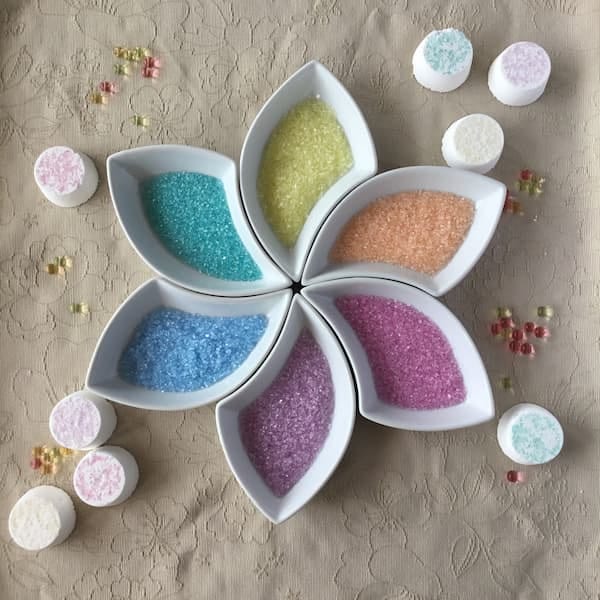
Epsom salts can also be used to make sparkly glitter that’s kind to the environment. The Dancing Soap Dish has a really useful tutorial on how to make this glitter using Epsom salts.
Raw Sugar & Food Colouring
Sugar also makes for a great eco-friendly glitter substitute. Whilst you can use any type of sugar, I’ve found that using raw sugar (also known as turbinado sugar) gives the best results. It’s a whole lot more sparkly, plus it doesn’t dissolve as easily as refined sugar. This means it does hold up a bit better with glue – although I would use it with Pritt-Stick rather than PVA glue.
Synthetic Mica
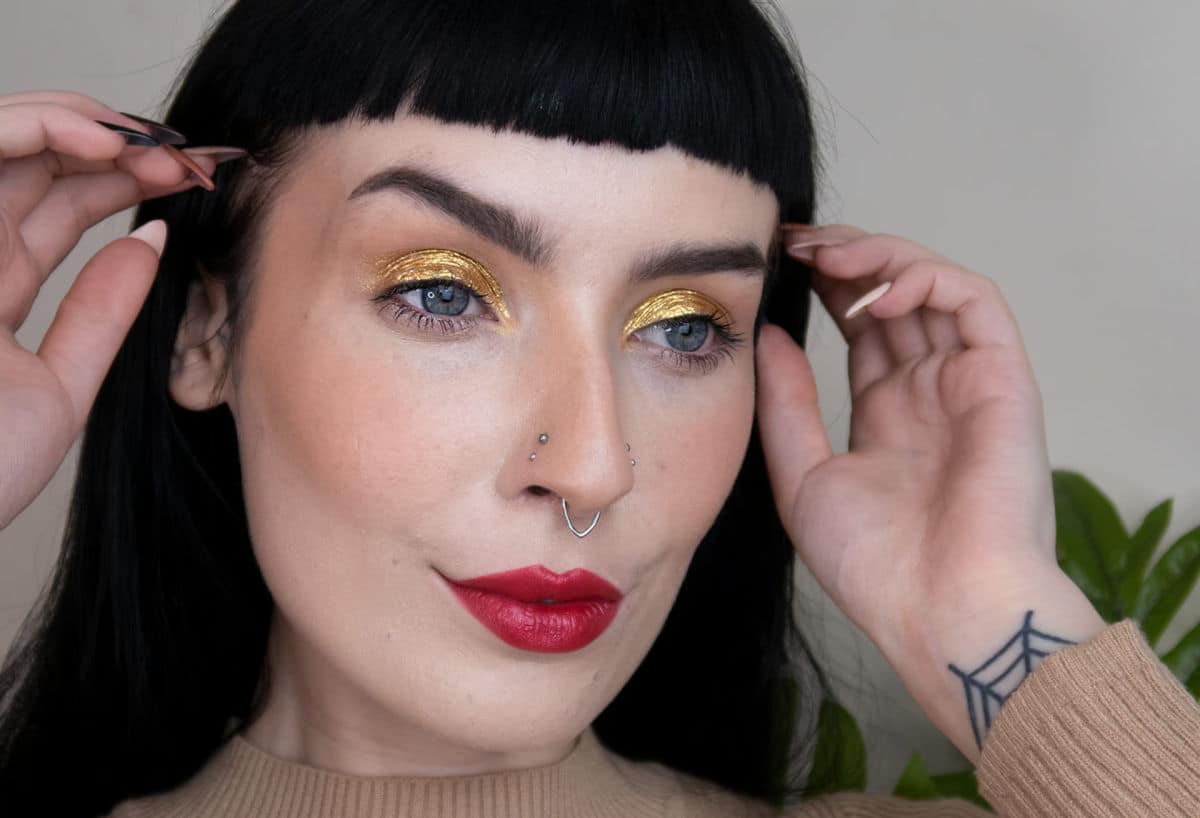
Mica offers a dazzling eco-friendly alternative to traditional glitter and is ideal if you’re looking to make your skin sparkle sustainably.
However, conventional mica is mined from rocks – and is associated with illegal mining and child labour. Instead, look for synthetic mica, from brands such as Lush, who offer all the sparkle without the bad bits. Alternatively, look for ethically sourced mica to ensure sustainability and fair labour practices.
Face Paint

Swap traditional glitter for eco-friendly face paint to add a bold pop of colour to your festival looks, or theatrical performances. Choose water-based, non-toxic formulas that don’t contain glitter or mica – unless it’s synthetic or ethically sourced – for a safe and sustainable sparkle.
Dried Flower Petals
Dried flower petals may not be the first thing that comes to mind when it comes to glitter alternatives, however, it is an eco-friendly way to add a splash of colour and texture to your kid’s artwork.
There’s no need to buy any dried flowers. You can keep it cheap and cheerful by sustainably harvesting a few herbs and flowers from your garden (making sure to leave plenty of flowers for bees and other pollinators) and then drying them out.
Once dried, you can pop the petals into little jars, and your kid can have lots of fun choosing between the different colours – just like they would with glitter.
Oats & Food Colouring
Oats make for another cheap eco-friendly glitter alternative for kids craft projects. Simply dye the oats with a little liquid food colouring, leave them to dry, and you’re done! It doesn’t sparkle, but it does add texture to mini masterpieces.
Rice
If you have a bag of dried rice to hand then you can use it to make glitter. Place some dried rice in a bowl (not the boil-in-the-bag or microwave stuff) and then add some food colouring. Spread it out on an oven dish to dry overnight, and the next morning you have a glitter substitute. It’s not as sparkly as using sand, but, like oats, it’s a good way to add texture.
Whilst I leave the grains as they are, I have heard of people putting the dried rice in a food processor to break the grains down into tiny pieces before dyeing them. This could be worth a try!
Lentils
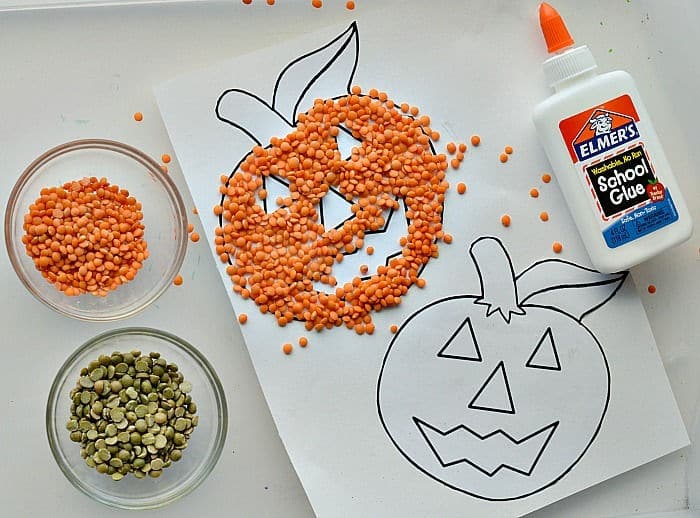
I have really fond memories of making pictures with dried lentils when I was at primary school. We would glue them down onto our pictures with PVA glue. Once the glue was dry, we’d then paint the lentils. It was an easy and effective way to add texture to our paintings without using glitter.
As I was looking for examples of this type of art, I was delighted to come across Fun Littles. They’ve gone further, and have cleverly used red and green dried lentils to make pumpkin art. It’s made for a great sustainable substitute for glitter, whilst still being fun for kids.
Seeds
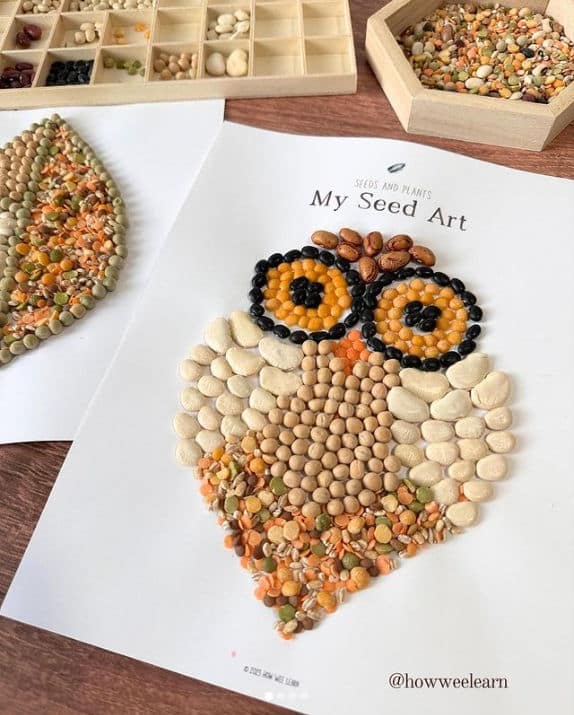
Similar to using lentils, you could use seeds instead of glitter for a more natural approach to crafting. Anything from pumpkin seeds to sunflower seeds, dried corn or spelt could be used. Simply stick, paint and repeat for fun works of art.
Check out How Wee Learn for these beautiful works of art that have been created using a mix of seeds and lentils.
Hole-Punched Recycled Paper
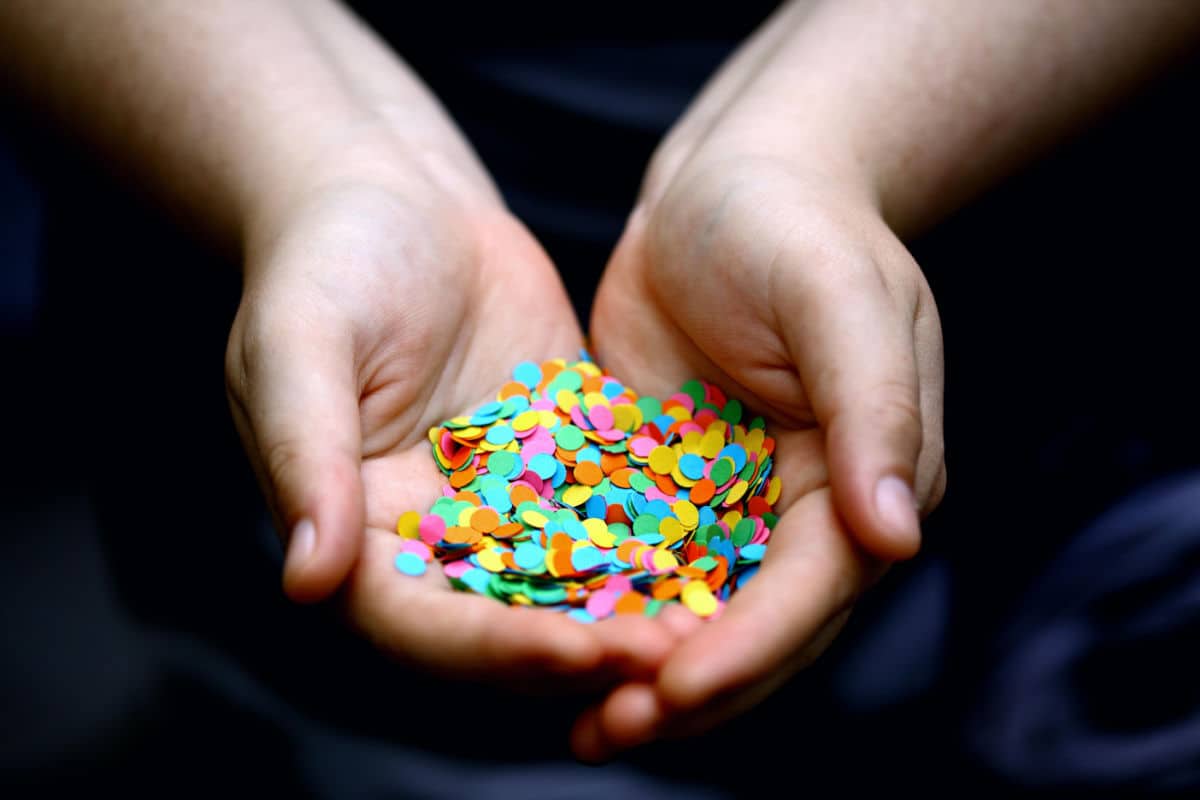
Finally, you can give new life to old magazines, newspapers, unwanted paintings or drawings, or cardboard by transforming them into colourful confetti using a hole punch. You can then use this to add colour to arts and crafts projects while reducing waste.
The Bottom Line
Glitter may look fun, but even biodegradable options are an environmental nightmare. The next time you’re looking to add a touch of sparkle to your face or body, consider synthetic mica or non-toxic face paints. And when it comes to adding glitz to works of art, you are spoiled for choice. From sand and seeds to recycled paper and dried flowers, there are a host of options that are gentle on the earth.
If you find any more eco-friendly glitter alternatives then do let me know in the comments below. Alternatively, if you find an altogether different alternative to glitter then I would love to hear about it!
Found this post useful? Please consider buying me a virtual coffee to help support the site’s running costs.



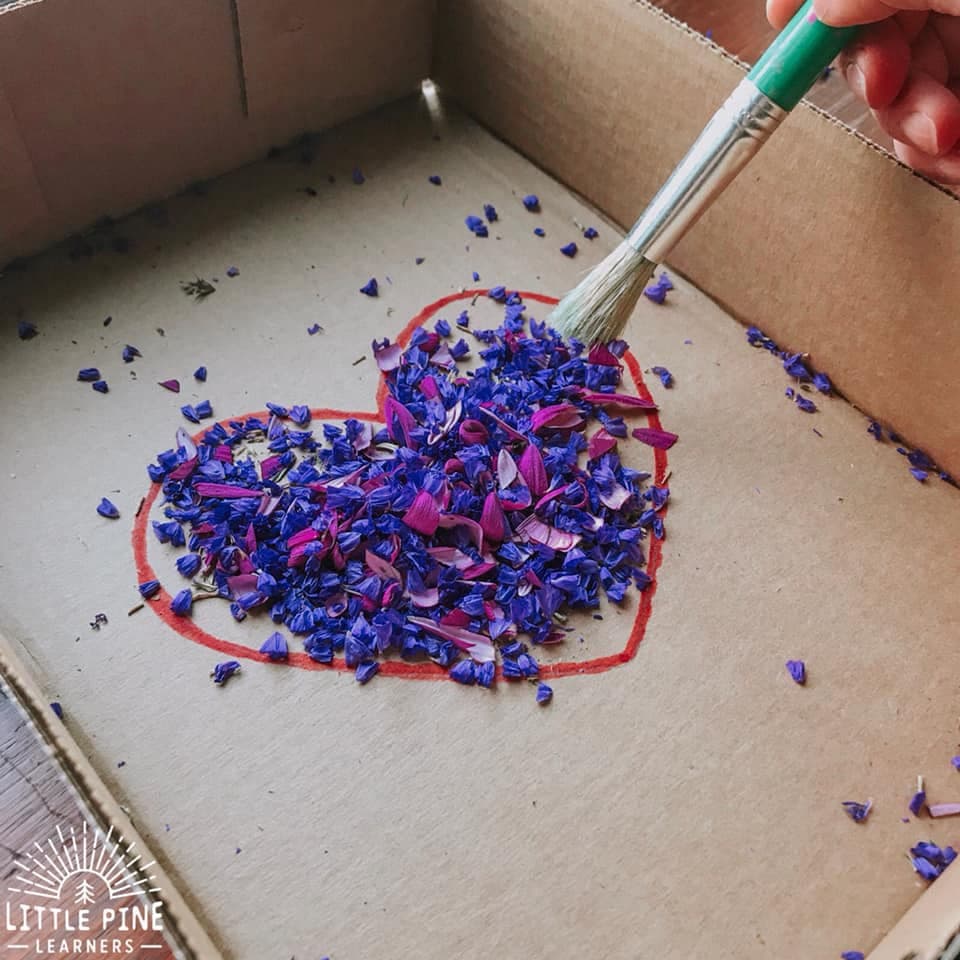
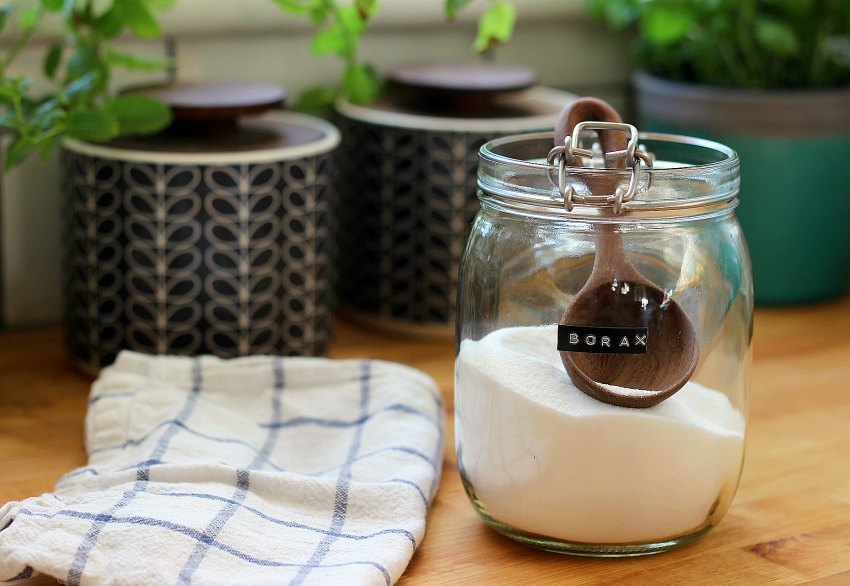
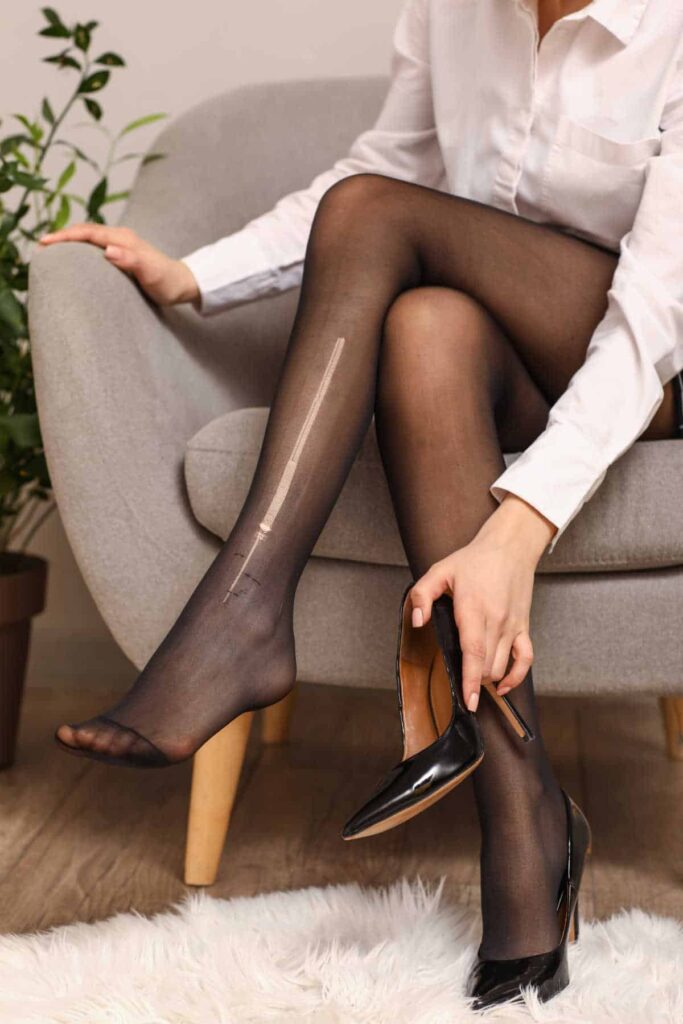

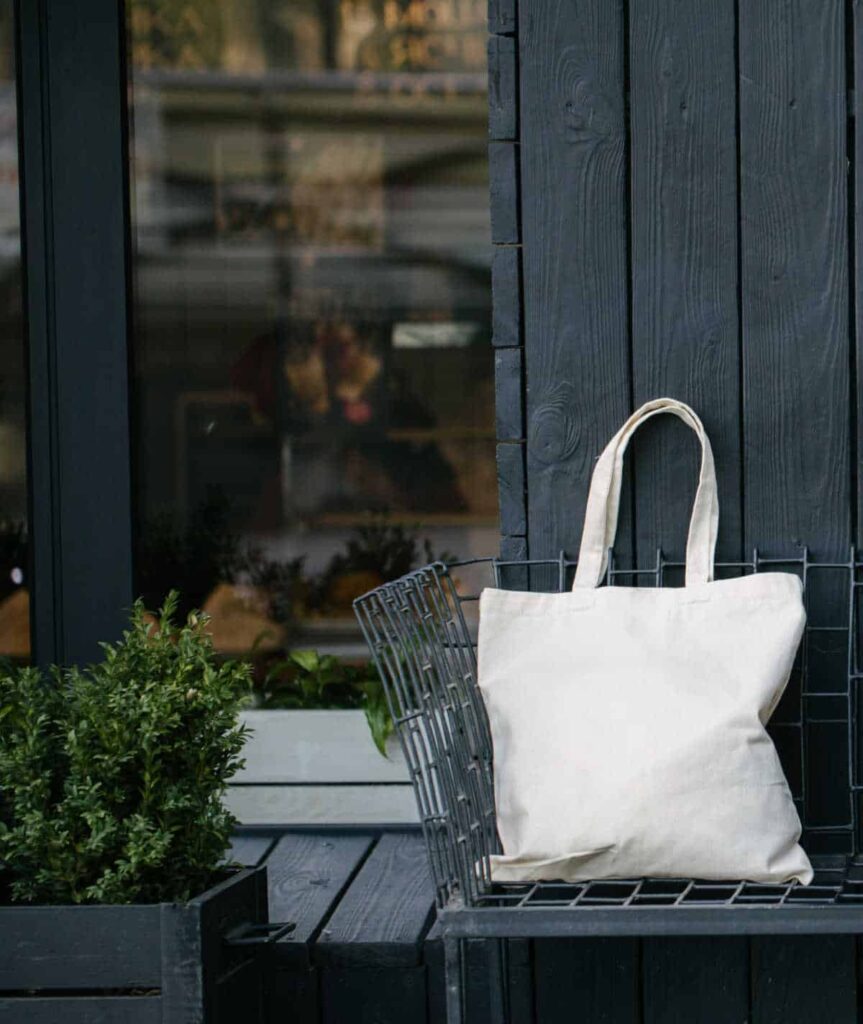
I was searching for ages for eco friendly glitter for my wax melts then I found https://scentssoapsandcandles.co.uk/category/candle-supplies/candle-glitter-mica/eco-sparkle-glitter/
This is great and environmently friendly. Hope this helps.
Hi, please don’t be misled by glitter – or any other products – labelled biodegradable or compostable are safe for the environment. Items claiming to ‘breakdown’ and be safe for the environment is a marketing con both for businesses and the consumer. Biodegradable products will only degrade if place in the correct waste disposal unit eg an industrial composter. This requires water, oxygen, movement and importantly, mega degrees of heat. We have very few facilities in the UK that can offer this. If you go in the shower or was you hands when covered in glitter, it will go down the drains and eventually into water outlets such as the sea. Biodegradable products will NEVER breakdown in water alone especially see/river water as this is too cold. Please be clear of such claims when trying to ease your environmental conscience. thanks :)
Take a look at a company called Conscious Crafts for biodegradable crafting glitter
Perhaps the answer is edible glitter. It is made mostly of sugar, and the dyes need to be safe for human consumption. Presumably they would be environmentally friendly, as well.
It is worth noting that biodegradable glitter may still have the same effects as plastic glitter and can even still last for years in the ecosystem before ‘degrading’. Many still also contain toxic dyes that can also accumulate up the food chain and affect the largest creatures in the sea.
I hate to be so negative, but the biodegradable thing always needs to be taken with a pinch of salt. Most of the harmful effect of plastic are from its physical presence and being biodegradable doesn’t inherently solve this.
My issue is that all these glitter manufacturers are producing cosmetic glitter. And £5 for a bottle is fine when I go to Glastonbury once a year. But I am looking for eco-glitter for toddler-crafting. At home and also as an incentive to pass on to Children’s Centres and nurseries. Especially come christmas, glitter is everywhere. So to find a company that does really affordable eco-glitter in bulk packages for kid’s venues would be amazing. I still have craft glitter at home but it sits there, stupidly, because I’m too afraid to use it. I contacted our local authorities about that issue, by the way, and they said that they are not aware of glitter being a problem for the water plant. Now, he could just be a moron, or it’s not as big an issue as assumed. Which I don’t really believe. A follow-up with the water plant is still due.
I completely judged this before I read it and HOW WRONG WAS I!!! I have been enlightened. Thank you so much for this. I never had given it a second thought!
Thanks for this, I’ve spoken to my son’s preschool to ask them to stop using glitter (and plastic/foam stickers etc, etc) and it will be helpful to be able to point them to biodegradable alternatives. But I keep wondering – what about the glue they use? Is that equally a problem?
Thanks so much for this! I love glitter and I too have been ignoring it’s micro-plastic-ness!
Hi Wendy. I didn’t realise glitter contained micro plastic although it’s been in the news lately. Great idea to list a few eco-friendly alternatives.
http://www.milliedollarbeauty.com for Eco Friendly cosmetic glitter
Do you have any idea what to do with glitter we already have in our homes? Just enjoy using it and don’t buy more?
Good question! I would say use it up in craft projects, but try and avoid using it for cosmetic purposes, where it’s more likely to be washed off under the tap or in the shower.
Sounds fantastic, especially as blue planet are now highlighting the terrible effects of glitter on marine life and the planet. I work in a special needs school and the children there put everything to their mouths so this would be a great alternative. Thank you.
Good old Attenborough – he’s my favourite! Hmm, I’m not too sure even eco friendly glitter would be great to ingest – maybe the edible glitter you get for baking might be more suitable for craft projects in this instance?
Love this article! I’ve only recently realised the awfulness of glitter too. You can find some other alternatives in my article for The Green Shopper here: http://thegreenshopper.co.uk/2017/11/18/not-all-that-glitters-is-green/
What a great article Ruth – love it!
Brilliant! Thanks for that!
My pleasure Lesley!